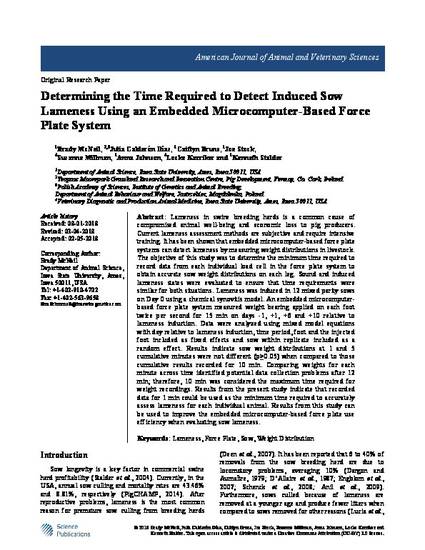
Lameness in swine breeding herds is a common cause of compromised animal well-being and economic loss to pig producers. Current lameness assessment methods are subjective and require intensive training. It has been shown that embedded microcomputer-based force plate systems can detect lameness by measuring weight distributions in livestock. The objective of this study was to determine the minimum time required to record data from each individual load cell in the force plate system to obtain accurate sow weight distributions on each leg. Sound and induced lameness states were evaluated to ensure that time requirements were similar for both situations. Lameness was induced in 12 mixed parity sows on Day 0 using a chemical synovitis model. An embedded microcomputer-based force plate system measured weight bearing applied on each foot twice per second for 15 min on days -1, +1, +6 and +10 relative to lameness induction. Data were analyzed using mixed model equations with day relative to lameness induction, time period, foot and the injected foot included as fixed effects and sow within replicate included as a random effect. Results indicate sow weight distributions at 1 and 5 cumulative minutes were not different (p≥0.05) when compared to those cumulative results recorded for 10 min. Comparing weights for each minute across time identified potential data collection problems after 12 min; therefore, 10 min was considered the maximum time required for weight recordings. Results from the present study indicate that recorded data for 1 min could be used as the minimum time required to accurately assess lameness for each individual animal. Results from this study can be used to improve the embedded microcomputer-based force plate use efficiency when evaluating sow lameness.
Available at: http://works.bepress.com/kenneth_stalder/234/

This article is published as McNeil, B. M., J. A. Calderón-Diaz, C. E. Bruns, J. D. Stock, S. T. Millman, A. K. Johnson, L. A. Karriker and K. J. Stalder. 2018. Determining the time required to detect induced sow lameness using and embedded microcomputer-based force plate system. American Journal of Animal and Veterinary Sciences 13: 59-65. doi: 10.3844/ajavsp.2018.59.65.